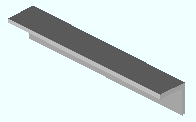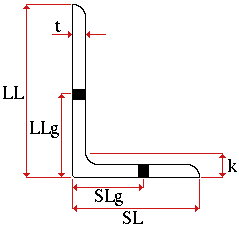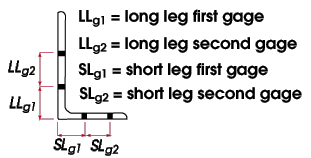Angle material

|
Angle material is rolled steel with a cross section that is "L" shaped. It has two legs that may or may not be equal in length. Angles are used extensively as connection materials for structural members. Other uses include curb angles, roof frames, edge angles, facia framing, lintels and braces.
|
Also see :
page 1 | contents | material types | shapes properties
Entering angle section sizes :
- Naming convention: L+long_leg_length+x+short_leg_length+x+thickness .
- Example: L5x3x1/2 .
- Note: When you add an angle to a shape file, you do not necessarily have to follow this naming convention.
- In Modeling and the Drawing Editor : An angle section must exist in the local shape file before you can enter it to " Section size " fields on member and material windows, or before its weight will be automatically calculated when you add it to the " Description " field in the bill editor.
page 1 | contents | material types | shapes properties | top
Submaterial piecemarking :
page 1 | contents | material types | shapes properties | top
Shape file settings for angles :
LL = long leg length
LLg = long leg gage
t = thickness
k = k distance
SL = short leg length
SLG = short leg gage
|

|
- For angle material with two columns of bolts per leg, you need to enter a separate Long leg first gage and Long leg second gage and Short leg first gage and Short leg second gage .

page 1 | contents | material types | shapes properties | top
Adding angle sections to the model :
- To add an angle to a member as a submaterial (pre-selection method): Select the one (1) member that you want to add the angle to (so that it is displayed in the " Primary selection color ") > press F3 > filter for "
 Hot / Cold Rolled " > double-click " Rolled Section " > locate two material work points > enter an angle " Section size " on the Rolled Section Material window > optionally rotate the material into place > locate a material dimension reference point > right-click ( Return ) if done adding material to the member > Change All Options can be applied if the angle is being added to a member that is batched together with other members that have the same member piecemark.
Hot / Cold Rolled " > double-click " Rolled Section " > locate two material work points > enter an angle " Section size " on the Rolled Section Material window > optionally rotate the material into place > locate a material dimension reference point > right-click ( Return ) if done adding material to the member > Change All Options can be applied if the angle is being added to a member that is batched together with other members that have the same member piecemark.
- To add an angle as a miscellaneous member : Press F2 > filter for "
 Miscellaneous steel " > double-click " Rolled Section " > locate two member work points > enter an angle " Section size " on the Rolled Section Edit window > right-click ( Return ) if you are done adding duplicates or variations of the miscellaneous member.
Miscellaneous steel " > double-click " Rolled Section " > locate two member work points > enter an angle " Section size " on the Rolled Section Edit window > right-click ( Return ) if you are done adding duplicates or variations of the miscellaneous member.
- To add an angle as a legacy miscellaneous member, click here for instructions.
- Locating work points for an angle that is added as material or a legacy miscellaneous member should be done in a view whose work plane is orthogonal to (at right angles to) the material being added. A rolled section miscellaneous membe , on the other hand, can be added and properly rotated into place even in an isometric view.
- Settings for angles added as legacy miscellaneous members or submaterial may be entered on the Rolled Section Material window. Settings for angle miscellaneous members may be entered on the Rolled Section Edit window. Additional settings can be found in the local shape file (see above ).
- Angle sections can also be added to the model as the main material of a member by inputting the appropriate section size (example: L4x3 12x7/8 ) to the field " Section size " on a member edit window. Connection design can generate automatic connections for angle vertical braces and angle horizontal braces .
- Angle sections that may be added to the model by connection design include: clip angles , beam seat stability angles , angle beam seats and moment flange angles .
- Angle sections must be entered to the Preferred Angle Sizes setup list in order for connection design to automatically generate angle seats (stiffened or unstiffened), bolted angle moment connections, or offset beam-to-beam framing.
- Angles with specific gols and submaterial piecemarks can be defined for the various " Clip Angle Configurations ."
page 1 | contents | material types | shapes properties | top
Modifying angles :
page 1 | contents | material types | shapes properties | top
Steel grades :
page 1 | contents | material types | shapes properties | top










